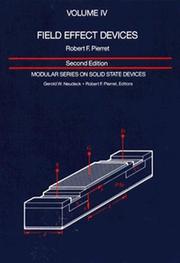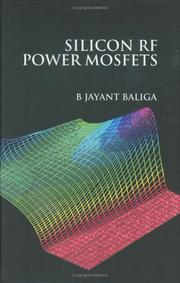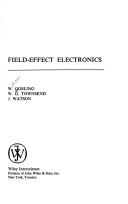| Listing 1 - 10 of 15 | << page >> |
Sort by
|
Book
ISBN: 0471161500 Year: 1970 Publisher: New York (N.Y.): Wiley
Abstract | Keywords | Export | Availability | Bookmark
 Loading...
Loading...Choose an application
- Reference Manager
- EndNote
- RefWorks (Direct export to RefWorks)
621.382.3 --- Field-effect transistors --- Unipolar transistors --- Transistors --- 621.382.3 Transistors --- FETs (Transistors)

ISBN: 0201122987 Year: 1990 Publisher: Reading (Mass.) Addison-Wesley
Abstract | Keywords | Export | Availability | Bookmark
 Loading...
Loading...Choose an application
- Reference Manager
- EndNote
- RefWorks (Direct export to RefWorks)
Field-effect transistors --- Unipolar transistors --- Transistors --- Field-effect transistors. --- FETs (Transistors)
Book
ISBN: 9535131761 9535131753 9535148044 Year: 2017 Publisher: IntechOpen
Abstract | Keywords | Export | Availability | Bookmark
 Loading...
Loading...Choose an application
- Reference Manager
- EndNote
- RefWorks (Direct export to RefWorks)
In 1959, Atalla and Kahng at Bell Labs produced the first successful field-effect transistor (FET), which had been long anticipated by other researchers by overcoming the ""surface states"" that blocked electric fields from penetrating into the semiconductor material. Very quickly, they became the fundamental basis of digital electronic circuits. Up to this point, there are more than 20 different types of field-effect transistors that are incorporated in various applications found in everyday's life. Based on this fact, this book was designed to overview some of the concepts regarding FETs that are currently used as well as some concepts that are still being developed.
Field-effect transistors. --- FETs (Transistors) --- Unipolar transistors --- Transistors --- Engineering --- Physical Sciences --- Engineering and Technology --- Electrical and Electronic Engineering --- Electronic Circuits

ISBN: 1281881007 9786611881009 9812569324 9789812561213 9812561218 9789812569325 9781281881007 9812561218 661188100X Year: 2005 Publisher: Singapore ; Hackensack, NJ : World Scientific,
Abstract | Keywords | Export | Availability | Bookmark
 Loading...
Loading...Choose an application
- Reference Manager
- EndNote
- RefWorks (Direct export to RefWorks)
The world-wide proliferation of cellular networks has revolutionizedtelecommunication systems. The transition from Analog to Digital RFtechnology enabled substantial increase in voice traffic usingavailable spectrum, and subsequently the delivery of digitally basedtext messaging, graphics and even streaming video.
Book
ISBN: 1523105461 1910242713 9781523105465 9781910242711 9781910242704 1910242705 Year: 2016 Publisher: Shawbury, England ; Shrewsbury, England ; Shropshire, England : Smithers Rapra,
Abstract | Keywords | Export | Availability | Bookmark
 Loading...
Loading...Choose an application
- Reference Manager
- EndNote
- RefWorks (Direct export to RefWorks)
Organic field-effect transistors. --- Transistor circuits. --- Electronic circuits --- Transistors --- OFETs (Transistors) --- Organic FETs (Transistors) --- Field-effect transistors --- Organic semiconductors --- Thin film transistors

ISBN: 0408701234 9780408701235 Year: 1971 Publisher: London: Butterworths,
Abstract | Keywords | Export | Availability | Bookmark
 Loading...
Loading...Choose an application
- Reference Manager
- EndNote
- RefWorks (Direct export to RefWorks)
Field-effect transistors --- Transistor circuits --- Transistors à effet de champ --- Circuits transistorisés --- 621.382.3 --- Electronic circuits --- Transistors --- Unipolar transistors --- 621.382.3 Transistors --- Transistors à effet de champ --- Circuits transistorisés --- FETs (Transistors)
Book
ISBN: 0890060908 9780890060902 Year: 1982 Publisher: Boston (Mass.) : Artech house,
Abstract | Keywords | Export | Availability | Bookmark
 Loading...
Loading...Choose an application
- Reference Manager
- EndNote
- RefWorks (Direct export to RefWorks)
Field-effect transistors --- Gallium arsenide --- Transistors à effet de champ --- Arséniure de gallium --- Gallium arsenide semiconductors --- Semiconductors --- Unipolar transistors --- Transistors --- Field-effect transistors. --- Gallium arsenide semiconductors. --- Transistors à effet de champ --- Arséniure de gallium --- FETs (Transistors)
Book
ISBN: 9811065500 9811065497 Year: 2018 Publisher: Singapore : Springer Singapore : Imprint: Springer,
Abstract | Keywords | Export | Availability | Bookmark
 Loading...
Loading...Choose an application
- Reference Manager
- EndNote
- RefWorks (Direct export to RefWorks)
This book discusses analytical approaches and modeling of the breakdown voltage (BV) effects on graphene-based transistors. It presents semi-analytical models for lateral electric field, length of velocity saturation region (LVSR), ionization coefficient (α), and breakdown voltage (BV) of single and double-gate graphene nanoribbon field effect transistors (GNRFETs). The application of Gauss’s law at drain and source regions is employed in order to derive surface potential and lateral electric field equations. LVSR is then calculated as a solution of surface potential at saturation condition. The ionization coefficient is modelled and calculated by deriving equations for probability of collisions in ballistic and drift modes based on the lucky drift theory of ionization. The threshold energy of ionization is computed using simulation and an empirical equation is derived semi-analytically. Lastly avalanche breakdown condition is employed to calculate the lateral BV. On the basis of this, simple analytical and semi-analytical models are proposed for the LVSR and BV, which could be used in the design and optimization of semiconductor devices and sensors. The proposed equations are used to examine BV at different channel lengths, supply voltages, oxide thickness, GNR widths, and gate voltages. Simulation results show that the operating voltage of FETs could be as low as 0.25 V in order to prevent breakdown. However, after optimization, it can go as high as 1.5 V. This work is useful for researchers working in the area of graphene nanoribbon-based transistors.
Engineering. --- Electronic circuits. --- Nanotechnology. --- Nanotechnology and Microengineering. --- Electronic Circuits and Devices. --- Field-effect transistors --- Materials. --- Unipolar transistors --- Transistors --- Molecular technology --- Nanoscale technology --- High technology --- Construction --- Industrial arts --- Technology --- FETs (Transistors) --- Electron-tube circuits --- Electric circuits --- Electron tubes --- Electronics
Book
ISBN: 0136869238 Year: 1982 Publisher: Englewood Cliffs : Prentice Hall,
Abstract | Keywords | Export | Availability | Bookmark
 Loading...
Loading...Choose an application
- Reference Manager
- EndNote
- RefWorks (Direct export to RefWorks)
Field-effect transistors --- Power transistors --- 621.382.3 --- 621.381 --- Junction transistors --- Power electronics --- Power semiconductors --- Transistors --- FETs (Transistors) --- Unipolar transistors --- 621.381 Power electronics --- Electronics --- FET (field-effect transistor) --- transistorversterkers --- transistoren --- Veldeffect-transistoren.
Book
ISBN: 3030683680 3030683672 Year: 2021 Publisher: Cham, Switzerland : Springer,
Abstract | Keywords | Export | Availability | Bookmark
 Loading...
Loading...Choose an application
- Reference Manager
- EndNote
- RefWorks (Direct export to RefWorks)
This book evaluates the influence of process variations (e.g. work-function fluctuations) and radiation-induced soft errors in a set of logic cells using FinFET technology, considering the 7nm technological node as a case study. Moreover, for accurate soft error estimation, the authors adopt a radiation event generator tool (MUSCA SEP3), which deals both with layout features and electrical properties of devices. The authors also explore four circuit-level techniques (e.g. transistor reordering, decoupling cells, Schmitt Trigger, and sleep transistor) as alternatives to attenuate the unwanted effects on FinFET logic cells. This book also evaluates the mitigation tendency when different levels of process variation, transistor sizing, and radiation particle characteristics are applied in the design. An overall comparison of all methods addressed by this work is provided allowing to trace a trade-off between the reliability gains and the design penalties of each approach regarding the area, performance, power consumption, single event transient (SET) pulse width, and SET cross-section. Explains how to measure the influence of process variability (e.g. work-function fluctuations) and radiation-induced soft errors in FinFET logic cells; Enables designers to improve the robustness of FinFET integrated circuits without focusing on manufacturing adjustments; Discusses the benefits and downsides of using circuit-level approaches such as transistor reordering, decoupling cells, Schmitt Trigger, and sleep transistor for mitigating the impact of process variability and soft errors; Evaluates the techniques described in the context of different test scenarios: distinct levels of process variations, transistor sizing, and different radiation features; Helps readers identify the best circuit design considering the target application and design requirements like area constraints or power/delay limitations.
Electronic circuits. --- Circuits and Systems. --- Electronic Circuits and Devices. --- Electron-tube circuits --- Electric circuits --- Electron tubes --- Electronics --- Field-effect transistors --- Soft errors (Computer science) --- Design and construction. --- Reliability. --- Computer science --- Errors --- FETs (Transistors) --- Unipolar transistors --- Transistors
| Listing 1 - 10 of 15 | << page >> |
Sort by
|

 Search
Search Feedback
Feedback About UniCat
About UniCat  Help
Help News
News